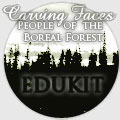Land

The northwest boreal forest presents a number of challenges for anyone attempting to travel overland from point to point. Forest trails can be narrow and tangled with close pressing trees and undergrowth. In the summer, wetland areas and muskeg have to be navigated around. In the long northern winters, snow can be hard packed or soft and deep, making travel an arduous undertaking at the best of times. Traditional hunting and trapping peoples living in the boreal forest had to adopt a number of strategies for successfully crossing the vast wooded landscapes of their home.
Much overland travel was done by foot, and traditional hunters and trappers would walk from trap set to trap set to check them, at times covering hundreds of kilometres as they traveled the length of their trapping area. To deal with the great distances involved, Aboriginal hunters and trappers built a series of line cabins along their overland trapline routes. These cabins would be set up every twenty to thirty kilometres or so, roughly the distance that could be covered overland in the day. Line cabins were overnight shelters, providing a place of rest and supplies to refresh a traveler on his or her journey.

In the summer, such overland travel was difficult enough, as bogs and soft muskeg could cover many hectares and had to be avoided. In the winter, when wet areas were frozen over, a trapper had much more access to various parts of the forest; ice and snow had to be contended with, and several methods were developed to deal with this. For walking, there were snowshoes. With wide wooden frames networked with rawhide webbing, snowshoes were a man made echo of nature. Animals well adapted to winter conditions had large broad feet that allowed them to travel overtop of deep snow. Snowshoes did the same for the human traveler by distributing the weight of the wearer over a wider surface to discourage sinking too deeply in softer snow.
Another method of winter travel that helped traditional hunters and trappers get around in the boreal forest was the toboggan pulled by dog-team. Toboggans, or carryalls, were particularly useful in that they provided a means of hauling a large set of supplies over snow. Toboggans were sturdy, made from tamarack or birch wood, and would be different sizes based upon the terrain that needed to be covered. A team of five to seven dogs would be harnessed to the sled, and could haul a weight on the sled that was roughly equal to the combined weight of the dog sled driver, or musher, and all the dogs in the team. A dog-team with toboggan could usually cover distances of fifty kilometres in a day’s travel, though a strong team with a light sled could cover almost three times that distance in good conditions. Fresh snowfall was difficult for dogs to push through, so often the musher would walk ahead of the team, to clear a trail for them.
Animals other than dogs could be trained to pull sleighs. Horses, and even moose or caribou, have been trained to pull toboggans or sleds at one time or another. Since the 1950s however, animals have been gradually replaced with mechanical vehicles. Snowmobiles and all-terrain vehicles often pull the sleds in more recent times, though those who favour more traditional modes of hauling a sled claim that a machine breaks down where a strong dog will not, and that a dog is much more likely to know the way home in poor conditions than a snowmobile is. Still, snowmobiles can haul greater loads over longer distances than dog team, and have made overland winter travel more efficient.
Regardless of the means of travel, one still had to know where one was going. An experienced traveler knew that the forest could point the way if he or she needed directions, by observing natural signs. Lichen or moss growth would often occur on the northwest side of trees, as the prevailing winds in northwest Canada move in from that direction. One could determine which direction one was moving in by paying close attention to such signposts. Lodgepole pines provided natural landmarks along established routes, as these trees drop their lower branches and end up with a knobby growth of branches and cones near the tree top. Such trees, called lobstick pines, would provide travellers with natural guide markers to help establish their position.





